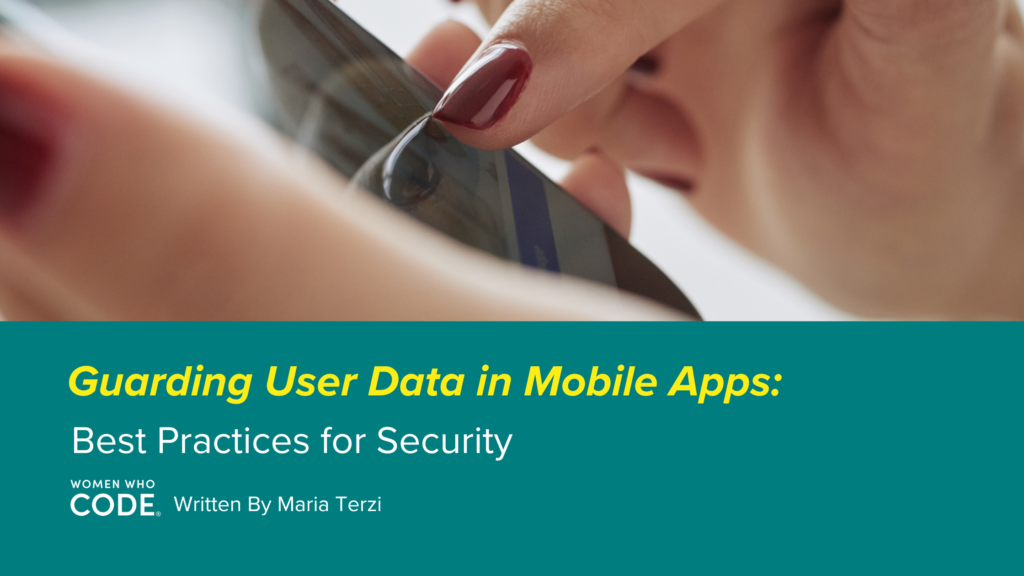Guarding User Data in Mobile Apps: Best Practices for Security
Written by Maria Terzi

Mobile apps have become an integral part of our daily lives. From communication to shopping and banking, we rely on mobile apps for convenience and efficiency. However, with convenience comes the responsibility of safeguarding sensitive data. In this technical blog post, we’ll explore essential strategies for building robust data security into mobile apps to protect user information.
1. Data Encryption: The First Line of Defense
Data encryption is the cornerstone of data security in mobile apps. When sensitive data, such as login credentials or financial information, is stored or transmitted, it must be encrypted. Implement end-to-end encryption to ensure data is secure during transmission, and use strong encryption algorithms for data at rest.
- Transport Layer Security (TLS): Use TLS to encrypt data in transit. Ensure your app communicates with servers via secure HTTPS connections.
- Database Encryption: Employ encryption mechanisms to protect data stored locally on the device. Android offers SQLCipher, and iOS provides the CommonCrypto library for secure data storage.
2. Secure User Authentication
Mobile apps often require user authentication. It’s crucial to implement robust authentication mechanisms to prevent unauthorized access.
- Biometric Authentication: Leverage biometric authentication methods like fingerprint or facial recognition for an additional layer of security.
- Multi-Factor Authentication (MFA): Implement MFA to require users to provide two or more verification methods, enhancing the security of their accounts.
3. Secure Data Transmission
Ensure the data your app sends and receives over the network is secure.
- Certificate Pinning: Implement certificate pinning to verify the server’s identity, preventing man-in-the-middle attacks.
- Data Validation: Validate user inputs and sanitize data to protect against common vulnerabilities like SQL injection and cross-site scripting (XSS).
4. API Security
If your app communicates with web services or APIs, ensure API security.
- OAuth2: Implement OAuth2 for secure authorization, allowing your app to access user data with user consent.
- API Rate Limiting: Implement rate limiting to prevent abuse and DDoS attacks on your APIs.
5. Data Minimization and Permission Control
Only collect the data your app truly needs, and ask for the minimum necessary permissions.
- Least Privilege Principle: Request only the permissions required for the app’s core functionality.
- Runtime Permissions: On Android, use runtime permissions to request sensitive permissions only when they are needed.
6. Local Data Storage Security
Secure the data stored locally on the user’s device.
- Keychain (iOS) and Keystore (Android): Store sensitive data securely using platform-specific secure storage mechanisms.
- File Encryption: Encrypt files and local storage using encryption libraries or platform APIs.
7. Regular Security Testing
Perform regular security testing, including penetration testing, to identify vulnerabilities and weaknesses in your app’s security.
- Static Application Security Testing (SAST): Use SAST tools to analyze your source code for security vulnerabilities.
- Dynamic Application Security Testing (DAST): Test your app in real-world conditions to identify vulnerabilities in runtime.
8. Secure Backend Practices
Your mobile app’s backend is a critical component of data security.
- API Security: Implement secure API design practices, use API gateways, and validate requests to prevent unauthorized access.
- Server Security: Protect your server with firewalls, intrusion detection systems, and strong access controls.
9. Regular Updates and Patch Management
Keep your app and its dependencies up-to-date to protect against known vulnerabilities. Swiftly apply patches and security updates.
10. User Education and Privacy Policies
Educate users about their role in app security and privacy.
- Privacy Policies: Clearly communicate your app’s data handling practices through a privacy policy.
- In-App Guidance: Provide tips and information about security best practices within the app.
Data security is a critical aspect of mobile app development. Building a secure mobile app not only protects user data but also fosters trust and credibility. Incorporate these strategies into your development process to create a mobile app that’s as secure as it is functional. Remember, when it comes to data security, it’s better to be proactive than reactive.
